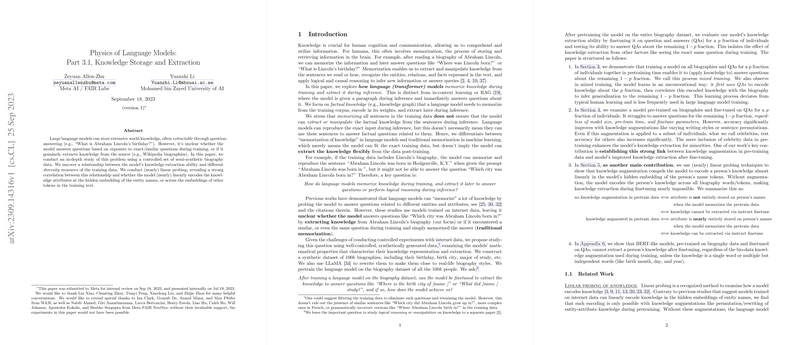Analysis of "Physics of LLMs: Part 3.1, Knowledge Storage and Extraction"
This paper explores the mechanisms through which LLMs encode and retrieve knowledge during inference, focusing specifically on their ability to extract factual data in response to questions. The paper explores the potential discrepancy between models simply memorizing data versus genuinely understanding and retrieving knowledge, using a synthetic biography dataset for controlled experimentation.
Key Findings
- Knowledge Storage and Extraction: The paper examines the nature of knowledge storage within LLMs. A significant find is that models may memorize biographical data but struggle to extract relevant knowledge upon query unless exposed to varied data representations during pretraining. This emphasizes the importance of data diversity in effective knowledge extraction.
- Role of Knowledge Augmentation: The paper highlights the efficacy of knowledge augmentation techniques, such as adding multiple data entries with varied structures or shuffling sentences. Models demonstrated improved QA accuracy post-finetuning when trained on augmented datasets, indicating that richer pretraining data leads to better generalization.
- Probing Techniques: The authors employ position-based (P-probing) and query-based (Q-probing) methods to understand how knowledge is stored in model weights. Their results show that with adequate data augmentation, knowledge is linearly encoded in the hidden layers. Conversely, without such augmentation, retrieval is complicated, supporting the notion that linear probing can provide valuable insights into knowledge representation.
- Influence of High-Profile Data: Introducing augmented data for a subset (analogous to "celebrity" data) improves memory extraction capabilities for non-augmented data ("minority" group). This indicates that increasing data volume and diversity for commonly queried items might benefit overall model performance in real-world applications.
- Comparison with Bidirectional Models: Experiments with models like BERT revealed limitations in knowledge extraction when models trained via masked LLMing (MLM) tasks. Knowledge retrieval was particularly effective only when the content was simple and independent, underscoring the dependency of BERT-like models on data structure during training.
Implications and Future Directions
- Data Augmentation: The paper underscores the necessity of integrating knowledge augmentation in pretraining to enhance LLM performance. For practitioners, this implies prioritizing diversity in training datasets, even if occasionally mimicking potential real-world noise, to foster better generalization and knowledge retrieval.
- Model Design: Insights from probing analyses can guide adjustments in model architecture or training strategies for more efficient knowledge retention.
- Applications and Extensions: By understanding memory dynamics better, LLMs could be improved for applications where factual retrieval is critical, such as personal assistant technologies and advanced QA systems.
In conclusion, this paper provides a comprehensive framework to understand and optimize knowledge storage and retrieval in LLMs, encouraging further research into model training methodologies to leverage these insights effectively. As AI continues to expand its applications, these strategies will be crucial for developing models that are not only large but also smartly knowledgeable.
